B'z: Difference between revisions
| Line 139: | Line 139: | ||
[[File:singlesh.png|link=]] [[File:albumsh.png|link=]] [[File:toursh.png|link=]] | [[File:singlesh.png|link=]] [[File:albumsh.png|link=]] [[File:toursh.png|link=]] | ||
===2005: === | ===2005: "[[Ai no Bakudan]]", "[[OCEAN]]", [[B'z LIVE-GYM 2005 "CIRCLE OF ROCK"|CIRCLE OF ROCK]] and [[B'z Television Appearances|TV Renaissance]]=== | ||
[[File:2005.png|link=]] | [[File:2005.png|link=]] | ||
[[File:singlesh.png|link=]] [[File:albumsh.png|link=]] [[File:toursh.png|link=]] | [[File:singlesh.png|link=]] [[File:albumsh.png|link=]] [[File:toursh.png|link=]] | ||
| Line 145: | Line 145: | ||
On April 6, B'z released their 14th studio album entitled ''[[THE CIRCLE]]''. During recording, the band was especially focused on creating an album of songs that would work well in a live setting. As far as personnel, [[Shane Gaalaas]] and [[Akihito Tokunaga]] again returned to perform on the record. The album's title stemmed from the collective feeling the band experienced after rejoining forces after the long break for solo projects in 2004. This feeling of "reincarnation" led to them titling the album "THE CIRCLE" as a way of signifying the return to the spirit of creating new music. Notably, the closing track was an original [[B'z English Songs|English song]] by the title of "[[THE CIRCLE|Brighter Day]]". However, the song was not performed live until a worldwide stream of [[B'z LIVE in Namba]]. It was later included in other internationally-based events, such as [[Pepsi NEX presents B'z PREMIUM LIVE]] which served as a warm-up to the North American tour [[B'z LIVE-GYM 2012 -Into Free-]]. | On April 6, B'z released their 14th studio album entitled ''[[THE CIRCLE]]''. During recording, the band was especially focused on creating an album of songs that would work well in a live setting. As far as personnel, [[Shane Gaalaas]] and [[Akihito Tokunaga]] again returned to perform on the record. The album's title stemmed from the collective feeling the band experienced after rejoining forces after the long break for solo projects in 2004. This feeling of "reincarnation" led to them titling the album "THE CIRCLE" as a way of signifying the return to the spirit of creating new music. Notably, the closing track was an original [[B'z English Songs|English song]] by the title of "[[THE CIRCLE|Brighter Day]]". However, the song was not performed live until a worldwide stream of [[B'z LIVE in Namba]]. It was later included in other internationally-based events, such as [[Pepsi NEX presents B'z PREMIUM LIVE]] which served as a warm-up to the North American tour [[B'z LIVE-GYM 2012 -Into Free-]]. | ||
Two weeks after the release of the album, B'z embarked on their nationwide tour [[B'z LIVE-GYM 2005 "CIRCLE OF ROCK"]]. The [[LIVE-GYM]] was especially noteworthy for featuring a rotating circular stage at the center of the arena and dome venues on which the band performed with the crowd encircling them. The tour began on April 17 and ran through September 19, finishing with a three night showing at [[Live Venues#Osaka Dome|Osaka Dome]]. The forty-one show tour began with a hall performance at [[Live Venues#Kushiro Civic Cultural Hall|Kushiro Civic Cultural Hall]] before proceeding to arena venues and then domes. As is customary for the band, a warm-up show, [[B'z SHOWCASE 2005 "Abashiri Extra Edition"]], was performed two days prior to the tour proper kicking off. Among the album songs from ''[[THE CIRCLE]]'' included in the setlists, a number of past singles also returned for the occasion, including "[[ALONE]]", "[[Konya Tsuki no Mieru Oka ni]]", and "[[IT'S SHOWTIME!!]]". In addition to the more distinguished songs, '90s B-sides "[[MOTEL|Mannequin Village]]" and "[[FIREBALL|Kanashiki dreamer]]". | Two weeks after the release of the album, B'z embarked on their nationwide tour [[B'z LIVE-GYM 2005 "CIRCLE OF ROCK"]]. The [[LIVE-GYM]] was especially noteworthy for featuring a symbolic rotating circular stage at the center of the arena and dome venues on which the band performed with the crowd encircling them. The tour began on April 17 and ran through September 19, finishing with a three night showing at [[Live Venues#Osaka Dome|Osaka Dome]]. The forty-one show tour began with a hall performance at [[Live Venues#Kushiro Civic Cultural Hall|Kushiro Civic Cultural Hall]] before proceeding to arena venues and then domes. As is customary for the band, a warm-up show, [[B'z SHOWCASE 2005 "Abashiri Extra Edition"]], was performed two days prior to the tour proper kicking off. Among the album songs from ''[[THE CIRCLE]]'' included in the setlists, a number of past singles also returned for the occasion, including "[[ALONE]]", "[[Konya Tsuki no Mieru Oka ni]]", and "[[IT'S SHOWTIME!!]]". In addition to the more distinguished songs, '90s B-sides "[[MOTEL|Mannequin Village]]" and "[[FIREBALL|Kanashiki dreamer]]". | ||
The tour originally went unreleased on [[B'z Home Videos|home video]]. Shortly thereafter, excerpted performances began to appear as bonus footage on various releases. The special iTunes download codes included in limited edition copies of ''[[B'z The Best "Pleasure II"]]'' at the end of the year featured a performance of "OCEAN", while the summer 2006 release of single "[[SPLASH!]]" featured color-coded releases with one performance each of "[[THE CIRCLE|Fever]]", "[[Ai no Bakudan|Pulse]]", and "[[Ai no Bakudan]]". A performance of "[[Samayoeru Aoi Dangan]]" from the arena portion of the tour was included in the 2008 bonus disc for ''[[B'z The Best "ULTRA Pleasure"]]''. Likewise in 2008, the special video compilation ''[[B'z LIVE-GYM Hidden Pleasure ~Typhoon No.20~]]'' featured performances of "[[BANZAI]]", "[[ultra soul]]", and "[[juice]]". The full show of the tour finale was at last released as ''[[B'z LIVE-GYM 2005 -CIRCLE OF ROCK- (Home Video)|B'z LIVE-GYM 2005 -CIRCLE OF ROCK-]]'' on DVD in February 2013 as part of the band's 25th anniversary campaign. | The tour originally went unreleased on [[B'z Home Videos|home video]]. Shortly thereafter, excerpted performances began to appear as bonus footage on various releases. The special iTunes download codes included in limited edition copies of ''[[B'z The Best "Pleasure II"]]'' at the end of the year featured a performance of "OCEAN", while the summer 2006 release of single "[[SPLASH!]]" featured color-coded releases with one performance each of "[[THE CIRCLE|Fever]]", "[[Ai no Bakudan|Pulse]]", and "[[Ai no Bakudan]]". A performance of "[[Samayoeru Aoi Dangan]]" from the arena portion of the tour was included in the 2008 bonus disc for ''[[B'z The Best "ULTRA Pleasure"]]''. Likewise in 2008, the special video compilation ''[[B'z LIVE-GYM Hidden Pleasure ~Typhoon No.20~]]'' featured performances of "[[BANZAI]]", "[[ultra soul]]", and "[[juice]]". The full show of the tour finale was at last released as ''[[B'z LIVE-GYM 2005 -CIRCLE OF ROCK- (Home Video)|B'z LIVE-GYM 2005 -CIRCLE OF ROCK-]]'' on DVD in February 2013 as part of the band's 25th anniversary campaign. | ||
Revision as of 23:32, 14 November 2014
| B'z | |
|---|---|
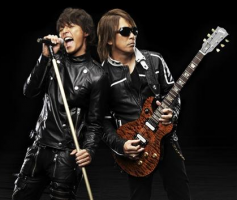 B'z is made up of guitarist-composer Tak Matsumoto and vocalist-lyricist Koshi Inaba. | |
| Background information | |
| Origin | Japan |
| Genres | Rock, Hard Rock, Pop Rock, Blues, Jazz, Dance, Adult Rock, Metal |
| Years | 1988–Present |
| Labels | BMG Japan (1988-1995) Vermillion Records (1995-Present) |
| Website | Official website |
| Members | |
| Tak Matsumoto Koshi Inaba | |
B'z is a Japanese rock band, comprised of guitarist-composer Tak Matsumoto and vocalist-lyricist Koshi Inaba. Since their debut in 1988, B'z have remained one of the most successful music acts in not just their home country but the world, having set a number of records that still stand today. Not only have they remained at the top of the charts for over two decades, they have done so while experimenting with a great many sounds in virtually every imaginable genre of music. In addition to their work as a group, both members have complimented their musical endeavors with storied solo careers.
Among the records set and held by B'z are the distinctions of having the most number one singles, of which all are consecutive, the most number one albums, and the most number one home video releases. Overall, B'z has sold over 35 million singles—the most in Japanese history—and have moved over 85 million records in total—the most ever sold by a band in their home country. B'z currently has over thirty releases that have sold over a million copies, including their first two best-of compilations, B'z The Best "Pleasure" and B'z The Best "Treasure", that remain the second and fifth highest selling albums in Japanese music history.
B'z concerts, referred to as LIVE-GYMs, have been characterized by their consistent quality, energy, and production value. In addition to playing shows all over Japan, the duo has performed live in the United States, Taiwan, Hong Kong, and Canada. In addition to their large-scale concerts, B'z also venture out to see fans in the form of SHOWCASE shows—concerts with setlists that typically include a great many scarcely-performed songs and take place at smaller, more intimate venues. Generally, they are often played as warm-ups to the larger LIVE-GYM concerts as well as a means of still touring for fans even when a major album promotion isn't in order, especially in areas of Japan that the band have not visited previously or have not visited in some time.
Since December 1988, a quarterly magazine has been available to members of the band's fanclub, B'z PARTY. Be With!, previously known as Be+wiZ!, began as more of a newsletter but has since evolved into a full magazine with thorough interviews with the band in each issue, recording diaries, detailed backstage reports, exclusive reveals, and a great deal of special features.
History
Origin of the name B'z
The origin of "B'z" comes in various forms, though both members have stated on more than one occasion that there was no deep meaning behind its creation, with it mostly being spontaneous and spur of the moment. The most prominent explanation was that they wanted to be an "A to Z" sort of band, a band from which you could expect any sort of music. This was shortened to "A~Z" and then "A'z", but the pronunciation possibly being mistaken for "AIDS" made it an unfavorable candidate, which led to "B'z". Koshi repeated this sentiment in the 2012 documentary Only Two in a New York interview during their latest United States and Canada tour. Additionally, the band wanted a name that was easy to recognize, something modern that would lend itself well to a logo and become a recognizable namesake.
The uncertainty behind the exact origin of the band's name has led to much fan and press speculation over the years. With the question being one of the most common the band have received in their decades on the music scene, a few additional and supporting explanations have also arisen. Tak mentioned in a 1989 interview that the idea of having a "Z" at the end was the result of a casual remark by a staff member, while the idea that "B'z" is associated with bees was supported when Koshi explained in an interview on TOKYO FM's "BEAT ZONE" program that the pronunciation of "B'z" was similar to "bees" in English, meaning a swarm of bees. Bee imagery would be featured during the year 1995 on the single for "love me, I love you" as well as serving as a motif for B'z LIVE-GYM Pleasure'95 "BUZZ!!".
Later, Tak was also quoted as saying he liked the idea of using a "Z" in the name and thought having a "B" would be appropriately masculine, with the number of associated "B" rock artists out there. Thus, adding the two together formed "B'z". Another popular explanation that emerged in the press was that the band wanted to be inclusive of their favorite rock artists, and thus the name "B'z" included "B" for The Beatles and "Z" for Led Zeppelin.
1988: Formation and Debut Album
In the mid-1980s, the music scene in Japan was awash with music that consisted primarily and often exclusively of digitally-generated sounds and rarely involved the full instrumentation one would expect of rock music. The state of popular music at the time was at odds with the rock culture that a young guitarist by the name of Tak Matsumoto had admired since his youth. Then a studio musician playing guitar on the albums of some of Japan's top emerging pop acts, such as TM Network and Mari Hamada, Tak was discontent with the lack of distinctive guitar work in the music industry and longed to create his own music. After a stint of touring and recording with Hamada and TM Network, the young guitarist was determined to emerge from the shadow of being a supporting artist and create his own musical identity.
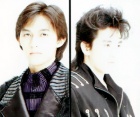
After departing from his supporting commitments, Tak set out to embark on his solo career where he would have control over the sound of his music. Solo instrumental albums were seeing a niche trend within a market that was starving for some sort of innovation, and thus Tak took advantage. On May 21, 1988, Thousand Wave, the debut album from twenty-seven year old guitarist Tak Matsumoto, was released to the Japanese public. The ten track album laid the foundation for Tak's early compositional style and offered the world the very first example of the prototypical B'z sound that would be of vital importance in the years to follow. In addition to offering a taste of what would become B'z music, it was here that Tak cemented another element of B'z history when friend and keyboardist Takanobu Masuda played on over half the album. Masuda had previously served as a fellow supporting member to Mari Hamada and would go on to tour with B'z more so than any other supporting member, having done so beginning in 1992 and would still be doing so even as of 2012.
The young Tak was satisfied with Thousand Wave and his first experience of being in control of the studio. At the same time, he felt he still hadn't even begun to reach his potential for what he wanted to accomplish in his musical career. As such, with the release of Thousand Wave, Tak felt that chapter of his career had ended and the next was soon to begin. It was then that he set out to realize his dream and thus began his search for others with which he could form a band to take to the top of the charts.
In May 1988, Tak—feeling confident with a guitar and not so much in his vocal ability—began searching for a vocalist with which to pair himself and begin his band project with. It was at that time that a music producer and friend by the name of Daiko Nagato introduced Tak to a demo tape from his collection of aspiring artists. The tape was a recording made several years prior by a university student who had made the tape with the hopes of being noticed and becoming a professional musician. The songs from the session that were then heard by Tak were covers of T-Bone Walker's "T-Bone Shuffle", Led Zeppelin's "You Shook Me", and Billy Joel's "Honest". The tape went unnoticed and unrewarded at the time and was filed away. Years after it had been recorded, the solo guitarist Tak Matsumoto was listening to the tape and immediately sensed a connection with his style of music and the voice he was hearing.
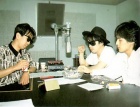
The voice on the tape belonged to a recent Yokohama National University graduate by the name of Koshi Inaba. Though he had been a student at the time the demo tape was authored, he had now graduated with a degree in mathematics and had embarked on the path of teaching the subject instead. The young Koshi had excelled at academics, particularly in English and math, and felt comfortable teaching the latter considering that, during the course of his university days, he had ranked third in the entire country in mathematics. It was not in teaching that his heart really belonged, however, and while his dreams of being a musician had begun to diminish with the responsibilities of the real world, he was not ready to give up entirely. When he suddenly received a call from a man named Tak Matsumoto to request an audition with concern to a demo he had recorded years earlier, Koshi was floored and immediately accepted the meeting.
The rendezvous took place at a small studio in Roppongi, Tokyo called "SOUND JOKER". There, the two mused over the music that they liked and found a great many similarities between them, including a mutual fondness of The Beatles. The pair reconvened the next day without a solid plan and decided to become more familiar with one another's styles by playing Beatles songs together. It was then that the two played through covers of "Oh! Darling" and "Let It Be" with only a microphone and guitar. However, shortly after the second song, the guitar amplifier malfunctioned and they had no choice but to call it a day. Despite the sudden inconvenience, both Tak and Koshi had heard enough and their newfound band was on its way. Twenty years later, after they had long topped the Japanese music scene and become its biggest artists, the two relayed this story and performed "Oh! Darling" under the same conditions, with only a microphone and guitar, to a crowd of over 70,000 during their sold-out 20th anniversary tour.
While the formation of the band came quite easily, Tak and Koshi said in later years that it was more of an organic than an arranged decision to start a band, with it all happening naturally. During their 1993 tour, "RUN", Tak joked on-stage that, "Come to think of it, we never did [outright agree we should form a band]", to which Koshi responded, "Let's do it then!". In the Japanese music industry at the time, the perception was that rookie artists should give up if they are unable to produce a hit within three albums. As a result, Tak said to Koshi in the early days that they should score the cover of Gb, a popular music magazine at the time, within three years.
From the band's founding through writing the music, producing, and recording their original works, it all occurred in a short period of around four months. At the onset of the first album's recording, Tak oversaw all aspects of the album, including presiding over Koshi's lyrics, who had no previous professional experience with songwriting. Very quickly, he recognized his partner's natural proficiency with the art, no doubt due to his extensive vocabulary with both Japanese and English and his ability to develop thematic themes seamlessly around the music Tak had written. This was to be the true beginning of the sound that would define B'z music in the decades to come. Tak continued writing all of the music and performing all guitar while Koshi sang and wrote all of the lyrics freely.
Finally, on September 21, 1988, the simultaneous releases of their self-titled debut album B'z and their first single, "Dakara Sono Te wo Hanashite", marked the beginning of a new era in the lives of Tak Matsumoto and Koshi Inaba as well as serving as the beginning of what would forever change the face and sound of Japanese music.
1989: Birth of the LIVE-GYM, OFF THE LOCK and Debut TV Appearances
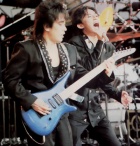
With the release of their first album, B'z had their first taste of building their own sound and developing their vision of what they wanted to accomplish in music. Their debut releases in 1988 did not make too big of a splash in the music scene, but did garner acclaim amongst those in the music community. The band were not especially concerned with the sales, however, as they had already decided they would not tour in support of the album and had a very different plan to most other new artists of the era. Their feeling was that, until they had enough material to perform a full live show, they would not be taking the stage as they wanted enough variety in their songs to give those who appeared at their shows a lasting, unique experience. The goal was to have 90 minutes of material to play a full show before going on tour, and as such, they immediately went back into the studio to write more music with the experience they had developing the first album together.
The aim was to create an album with songs that would be single-worthy. However, this was also the most trying time for Koshi as a lyricist. In subsequent interviews, Koshi mentioned feeling like giving up at several points, but was encouraged by Tak who said his lyrics were getting better and better. Though a stressful recording process, one of which consumed nearly 1,000 total hours in and around the studio by some accounts, Koshi's resilience with the album's lyrics paid off. Through the album, he was able to explore lyrical themes dealing with daily life, as well as romantic relationships and endeavors as well as its place in friendships. From the sessions, the unexpected live hit "OH! GIRL" emerged: an upbeat and optimistic pop-rock number that still frequents their live setlists to this day and is arguably their most successful of their older songs.
Once recording had been completed, B'z made their debut on the live stage when they appeared at the Nemu no Sato Resort for the SF Rock Station finale event entitled "Thank You TM Network". Tak had previously served as the guitarist for TM Network prior to departing for his solo career and thus he and Koshi made their first live appearance in support. Their brief setlist of five songs included their debut single "Dakara Sono Te wo Hanashite" and its B-side "Heart mo Nureru Number ~stay tonight~" as well as debut album songs "It's not a dream" and "Half Tone Lady". Most notably, their next single was debuted as their final performance of the evening and would later become known as "Kimi no Naka de Odoritai". The song, also soon to be included on their follow-up album, was a high-energy rock-dance song that showed the versatility they had been honing in the studio over their original efforts.
The ten-track resulting album entitled OFF THE LOCK was released only nine months after the first on May 21, 1989. The band's second single "Kimi no Naka de Odoritai" was, as was the case with their original releases, released simultaneously. The album's title came from the idea that the work would be "removing the lock" for the band, to allow them to explore their potential as a full rock band on the live stage with nothing left holding them back. Upon release, the album debuted at number 33 on the Weekly Oricon Albums chart, ranking fifteen slots ahead of their earlier debut album. While the releases did not lead to especially great mainstream success, it did lay the foundation for their forthcoming live shows that would bring B'z to the attention of the music industry and music fans alike. It would only be a matter of months before B'z had their first major hit and were on their way to stardom.
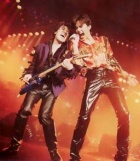
With two complete albums in the bag, the band finally felt they would be able to confidently hit the live stage and play a full show of their own material. As such, their first live tour was scheduled: B'z LIVE-GYM 00 "OFF THE LOCK", a three-date engagement at three well-known music venues from June 1 to June 5, 1988. The brief tour was to serve to test the waters but came up with very unexpectedly positive results. The three shows, in Nagoya, Osaka, and lastly Tokyo, sold out completely on the very first day tickets were made available, despite them being for a relatively new band that had not played on tour before. The regional tour was a massive success for the newly-established band, and established many of the core components that would remain intact for B'z shows decades later, including Tak playing a solo midway through the setlist. The setlist remained the same for all three shows, with "Dakara Sono Te wo Hanashite" being reserved for the one and only song played during the encore.
The success of their first major live endeavor was not one taken lightly. Immediately, Tak and Koshi returned to the studio in order to expand their catalogue with the feeling that there was more they could do beyond their second album. It was during these sessions that one of their most well-known songs, even two decades later, would emerge. The resulting mini album ran a massive 22 minutes for only three tracks and gave the band the chance to explore their depth and try new things in the studio outside of a proper album release. It was then that "BAD COMMUNICATION", the title song of the aforementioned mini album, was born. However, neither Tak nor Koshi expected the work to be a hit. The release was carried out only as an experiment in the studio, and approached as a stepping stone between their second and third albums. This free-form exploration led to their break through, with the public finally getting the chance to glimpse just what the duo were capable of on the music scene.
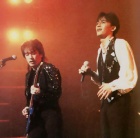
During the sessions, B'z also took their first stab at English songs as well, due to Koshi's proficiency with English and their mutual admiration for Western rock music. English versions of their debut single and an earlier album song were created, under the titles of "DA.KA.RA.SO.NO.TE.O.HA.NA.SHI.TE -OFF THE LOCK STYLE-" and "OUT OF THE RAIN -OFF THE LOCK STYLE-"—the latter of which remains their longest song, at 7 minutes, 38 seconds. Additionally, B'z took the opportunity during the same sessions to simultaneously create an English version of "BAD COMMUNICATION" as well, though it would not be included on the release.
When its late October 1989 release arrived, "BAD COMMUNICATION" took the Japanese music world by storm. Debuting at number 12 on the Weekly Oricon Albums chart, the ranking was a twenty-one spot improvement over OFF THE LOCK. Heavy radio play brought much attention to the band, and from there their success was cemented. At the time of release, a second tour, B'z BAD-CLUB GYM, was organized as a tour of club venues that lasted three dates from mid-to-late October. The setlist was unusual in that it began with three English songs: "Bad Communication E.Style", "DA・KA・RA・SO・NO・TE・O・HA・NA・SHI・TE -OFF THE LOCK STYLE-", and "OUT OF THE RAIN -OFF THE LOCK STYLE-". Afterward, the setlist was a mix of songs from their first two albums prior to culminating in a one-song encore of the original Japanese version of "BAD COMMUNICATION".
Afterward, B'z immediately embarked on their first nationwide tour, due to increasing public demand. The tour, B'z LIVE-GYM #001 "OFF THE LOCK", saw the band performing their biggest shows to date, with a full 17-song setlist. Concurrently, a short tour entitled B'z CAMPUS-GYM "OFF THE LOCK" took place—a two-date run of college campuses and the only one of its kind in the band's history. The unexpected explosion in attention led the band to a great many more promotional opportunities than they had planned, including their first television appearance performing "BAD COMMUNICATION" on November 24, 1989 for Hit Studio Night R&N. This would be the first of several early television appearances by B'z on the program, including an encore appearance just one month later on December 15 again performing the same song.
Their work in 1989 propelled B'z to the national spotlight, with hits on all fronts, from albums to television to the live stage. While impressive on its own merits, it would not be until the following year that the band truly found their break through, when they began an unprecedented record, released their first home video, and undoubtedly changed the way that music in Japan was seen by the general public.
1990:




1991:




1992:




1993:




1994:




1995:




1996:




1997:




1998:




1999:




2000:




2001:




2002:




2003:




2004:




2005: "Ai no Bakudan", "OCEAN", CIRCLE OF ROCK and TV Renaissance




On April 6, B'z released their 14th studio album entitled THE CIRCLE. During recording, the band was especially focused on creating an album of songs that would work well in a live setting. As far as personnel, Shane Gaalaas and Akihito Tokunaga again returned to perform on the record. The album's title stemmed from the collective feeling the band experienced after rejoining forces after the long break for solo projects in 2004. This feeling of "reincarnation" led to them titling the album "THE CIRCLE" as a way of signifying the return to the spirit of creating new music. Notably, the closing track was an original English song by the title of "Brighter Day". However, the song was not performed live until a worldwide stream of B'z LIVE in Namba. It was later included in other internationally-based events, such as Pepsi NEX presents B'z PREMIUM LIVE which served as a warm-up to the North American tour B'z LIVE-GYM 2012 -Into Free-.
Two weeks after the release of the album, B'z embarked on their nationwide tour B'z LIVE-GYM 2005 "CIRCLE OF ROCK". The LIVE-GYM was especially noteworthy for featuring a symbolic rotating circular stage at the center of the arena and dome venues on which the band performed with the crowd encircling them. The tour began on April 17 and ran through September 19, finishing with a three night showing at Osaka Dome. The forty-one show tour began with a hall performance at Kushiro Civic Cultural Hall before proceeding to arena venues and then domes. As is customary for the band, a warm-up show, B'z SHOWCASE 2005 "Abashiri Extra Edition", was performed two days prior to the tour proper kicking off. Among the album songs from THE CIRCLE included in the setlists, a number of past singles also returned for the occasion, including "ALONE", "Konya Tsuki no Mieru Oka ni", and "IT'S SHOWTIME!!". In addition to the more distinguished songs, '90s B-sides "Mannequin Village" and "Kanashiki dreamer".
The tour originally went unreleased on home video. Shortly thereafter, excerpted performances began to appear as bonus footage on various releases. The special iTunes download codes included in limited edition copies of B'z The Best "Pleasure II" at the end of the year featured a performance of "OCEAN", while the summer 2006 release of single "SPLASH!" featured color-coded releases with one performance each of "Fever", "Pulse", and "Ai no Bakudan". A performance of "Samayoeru Aoi Dangan" from the arena portion of the tour was included in the 2008 bonus disc for B'z The Best "ULTRA Pleasure". Likewise in 2008, the special video compilation B'z LIVE-GYM Hidden Pleasure ~Typhoon No.20~ featured performances of "BANZAI", "ultra soul", and "juice". The full show of the tour finale was at last released as B'z LIVE-GYM 2005 -CIRCLE OF ROCK- on DVD in February 2013 as part of the band's 25th anniversary campaign.
For the arena leg of "CIRCLE OF ROCK", a new and unreleased song entitled "OCEAN" was premiered in the encore. This would be one of several occasions in which B'z premiered a song live before its release. The song would become available as a single on August 10 and was the band's thirty-fifth consecutive single to reach the number-one spot on the charts. The uplifting and soulful ballad would prove to be one of the band's most popular songs of the sort, with a great many performances to follow during numerous tours. The music video received considerable acclaim and was filmed at sea atop a Japan Coast Guard helicarrier.
The year was an unusually prolific one for the band in regards to television appearances. The sole single from THE CIRCLE, "Ai no Bakudan", was performed on nine different television shows throughout the year with the first coming on HEY!HEY!HEY on February 28. The band made further appearances on CDTV, Music Station, MUSIC FIGHTER, and TV Minna. A March 26 broadcast on Fuji TV brought a special B'z episode of Our Music, which featured a full-length special retrospective interview with Tak Matsumoto and Koshi Inaba interspliced with performances of 1995's "love me, I love you", the recent single, and "Fever". In December, B'z closed the year on the annual Music Station SUPER LIVE 2005 special where they were the keynote artists, performing both "OCEAN" and the Christmas classic "Itsuka no Merry Christmas".
2006:




2007:




2008:




2009:




2010:




2011:
2012: English Album, 50th Single and Largest North American Tour
2013: 25th Anniversary, B'z The Best XXV Albums and ENDLESS SUMMER

Hot on the heels of their 2012 foray into North America, B'z began the new year with the triad of home videos announced in November 2013 that would serve to begin their 25th anniversary campaign. Accordingly, B'z LIVE-GYM 2008 -ACTION- was released in January, B'z LIVE-GYM 2005 -CIRCLE OF ROCK- in February, and finally B'z LIVE-GYM 2001 -ELEVEN- in March. Previous interviews in Be With! hinted for months what fans already knew: a 25th anniversary tour would commence sometime in 2013, but the exact timing, extent, and form it would take would go unknown in the year's early months. As had been the case with earlier anniversaries, a compilation album was expected sometime in the year to commemorate the band's twenty-five years on the music scene.
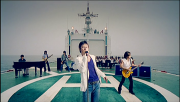
Finally, in late March, all silence was broken and the band's full anniversary plans were announced. Instead of one new compilation, fans were treated to two collections that, for the first time, set out to gather together all 50 singles and came in the form of B'z The Best XXV 1988-1998 and B'z The Best XXV 1999-2012. The two compilations also contained four brand new songs between them, with the limited edition copies coming with, for the first time, all of the associated music videos on home video. Additionally, B'z LIVE-GYM Pleasure 2013 -ENDLESS SUMMER- was at last announced: a full-blown tour that would tour halls throughout Japan from June to July, and then take on the nation's biggest domes from August all the way through their September 21 and 22 anniversary shows at B'z favorite Nissan Stadium.

In April, the band were announced for a double-headlining gig with Aerosmith—their second occasion joining forces following the 2002 FIFA World Cup International Day Concert eleven years earlier. Set for August 8, the event was dubbed AEROSONIC and was to take place as the opening event for the year's annual SUMMER SONIC music festival. When the show came, the two bands each performed full sets, with B'z also joining Aerosmith on stage for a rendition of their classic rocker "Mama Kin".
The band rounded out 2013 with plenty of performances, including a showing on Music Station during a "B'z 25th Anniversary Special" that featured an unprecedented four performances from B'z alone, with three coming as a result of fan requests. The show began with a B'z performance of new song "Q&A" and was followed by "LOVE PHANTOM", "Hadashi no Megami"—itself receiving its television debut—and finally "ultra soul" as the top vote-getter. A special YouTube program featuring an hour long interview with Tak and Koshi was also later aired live, featuring the band answering in-depth questions from fans that had been gathered in the weeks prior.
In November, B'z appeared as the inaugural performers for a special show at EX THEATER ROPPONGI. Shortly thereafter, news came down that B'z would be releasing the home video for the year's tour early in 2014 entitled B'z LIVE-GYM Pleasure 2013 ENDLESS SUMMER -XXV BEST-. The package was announced to come in a standard package and a complete edition, the latter of which features nearly six hours of footage between the tour finale at Nissan Stadium and the special hall tour finale earlier in the tour, as well as a documentary documenting the full 25th anniversary year.
2014: Break for Solo Projects New Horizon and Singing Bird, Return to B'z Activities

The year began with the home video release B'z LIVE-GYM Pleasure 2013 ENDLESS SUMMER -XXV BEST-. Released on both DVD and Blu-ray in two editions, the release spanned from three to six hours of footage covering the entire breadth of the tour. As the release loomed, however, Tak and Koshi spared no time for relaxation and instead headed to the studio to work on their respective solo projects.
< NOTE: This article is a perpetual work in progress that will be expanded gradually with time. >
Records & Accolades
Success Abroad
The band's success has led them to receive accolades and acknowledgment far outside of Japan. In 2002, American rock icons Aerosmith were invited to headline the International Concert Day event at the 2002 FIFA World Cup that was co-hosted by Japan and South Korea, and they agreed, but with the stipulation that they would only do so if B'z headlined with them. Ultimately, B'z and Aerosmith shared the same stage as the two bands performed hit after hit until finally the two joined forces for a rendition of the classic rock tune "Train Kept A Rollin'".
On November 19, 2007, B'z received the honor of becoming the first Asian musicians to be inducted to the Hollywood RockWalk in Los Angeles, California. This was not the first time B'z broke new ground in the global music industry, however. In 1999, Tak became the first Asian guitarist to become a signature Gibson artist and has, ever since, sported and introduced to the public numerous Gibson guitars designed to his specifications—most of which have quickly sold out in their initial production runs.
B'z have forged relationships with many of the top personalities in rock music, including guitar virtuoso Steve Vai, fellow American guitarist Stevie Salas, Slash of Guns N' Roses, Chad Smith of the Red Hot Chili Peppers, Juan Alderete of the Mars Volta, the members of rock band Mr. Big, as well as Canadian drummer Shane Gaalaas and bassist Barry Sparks, who have become fixtures of the B'z touring crew as they tour in Japan and abroad. In 2010, Tak collaborated with renowned jazz guitarist Larry Carlton on an "east meets west"-themed instrumental album titled Take Your Pick, which would go on to earn the pair a Grammy Award for Best Pop Instrumental Album and make Tak the first Japanese guitarist to be bestowed with the honor.
B'z Discography
Singles
Albums
|
|
|
Home Videos
- 1. FILM RISKY (1990)


- 2. JUST ANOTHER LIFE (1991)


- 3. LIVE RIPPER (1993)


- 4. "BUZZ!!" THE MOVIE (1996)


- 5. B'z OFFICIAL BOOTLEG (1998) — Video mailed to B'z PARTY members in 1998 for the band's 10th anniversary

- 6. The true meaning of "Brotherhood"? (1999)


- 7. once upon a time in Yokohama ~B'z LIVE GYM'99 "Brotherhood"~ (2000)


- 8. a BEAUTIFUL REEL. B'z LIVE-GYM 2002 GREEN ~GO★FIGHT★WIN~ (2002)


- 9. Typhoon No.15 ~B'z LIVE-GYM The Final Pleasure "IT'S SHOWTIME!!" in Nagisaen~ (2004)


- 10. B'z LIVE-GYM 2006 "MONSTER'S GARAGE" (2006)


- 11. B'z LIVE in Namba (2008)


- 12. B'z "ULTRA Pleasure" Premium Live DVD (2008) — Included in limited edition of B'z The Best "ULTRA Pleasure"

- 13. B'z SHOWCASE 2007 -19- at Zepp Tokyo (2008) — Included in limited edition of B'z The Best "ULTRA Treasure"

- 14. B'z Official Bootleg Hidden Treasure ~Typhoon No.20~ (2008) — DVD mailed to B'z PARTY members in 2008 for the band's 20th anniversary

- 15. B'z LIVE-GYM Hidden Pleasure ~Typhoon No.20~ (2008)

- 16. B'z LIVE-GYM Pleasure 2008 -GLORY DAYS- (2009)


- 17. B'z LIVE-GYM 2010 "Ain't No Magic" at TOKYO DOME (2010)


- 18. B'z LIVE in Namba 2006 & B'z SHOWCASE 2007 -19- at Zepp Tokyo (2010) — Blu-ray double package collecting B'z LIVE in Namba and B'z SHOWCASE 2007

- 19. B'z LIVE-GYM 2011 -C'mon- (2012)


- 20. B'z LIVE-GYM 2008 -ACTION- (2013)


- 21. B'z LIVE-GYM 2005 -CIRCLE OF ROCK- (2013)

- 22. B'z LIVE-GYM 2001 -ELEVEN- (2013)

- 23. B'z LIVE-GYM Pleasure 2013 ENDLESS SUMMER -XXV BEST- (2014)











